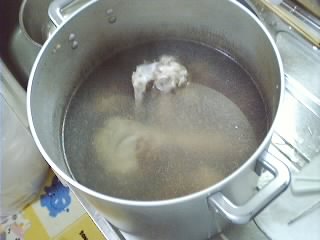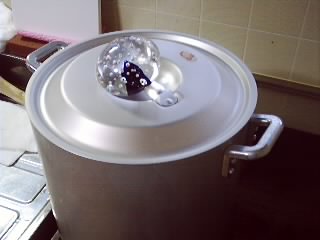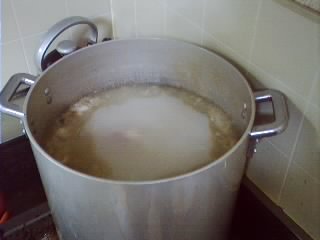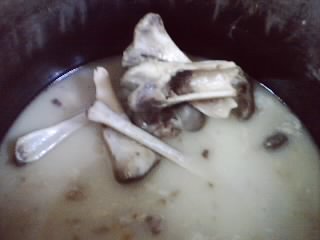
Here is the “professional recipe” for tonkotsu ramen as promised!
INGREDIENTS: (will provide 3.5 litres soup, enough for quite a few servings!)
-Pork bones: 5 (2500 g)
-Water: 13 litres
Voici la recette tant convoitée des ramen tonkotsu !
INGREDIENTS (Pour 3,5 litres de soupe, donc quelques portions !) :
- Os de porc : 5 (environs 2,5 kg)
- Eau : 13 litres
RECIPE:
Bring frozen bones to room temperature in plenty of water.
It should take about 2 hours. If you cook frozen bones directly, the blood will solidify and will be very difficult to get rid of.
If you can get fresh bones, skip this step.
Si vos os sont congelés, veillez à les mener à température ambiante dans une récipient bien remplie.
Cela devrait prendre deux heures, mais c’est une étape nécessaire car si vous utilisez vos os congelés directement le sang va se solidifier et vous aurez du mal à vous en débarrasser. Sautez cette étape si vous avez des os “frais”.
Fill a very large cooking pot with water and bring to boil.
Remplir une bonne marmite avec l’eau que vous porterez à ébullition.
Switch off fire as soon as the water boils. Drop in the bones and let cool. This process will help you get rid of the blood and blood vessels easily.
Coupez le feu dés que l’eau boue. Mettez-y les os et laissez refroidir. Cette étape est celle qui vous permettra d’éliminer le sang et les grosse particules de sang.
Leave it to cool down for 30~40 minutes.
Laissez retomber la température pendant une bonne demi-heure.
Drain the water off the bones in a large strainer.
Throw off the water.
Check and take off any blood or blood vessels from the bones.
Don’t forget to clean the pot!
Break all the bones in two with a hammer.
Egouttez bien les os dans une passoire, puis jetez cette eau souillée. Si vous repérez du sang ou des particules de sang, il est encore temps de les prendre. N’oubliez pas de nettoyer le pot.
Ensuite… Détruisez-les au marteau ou avec tout autre outil de cet acabit.
Fill the pot again with clear water and bring to boil.
Drop the bones inside.
Remplissez le pot à nouveau avec de l’eau propre que vous ferez bouillir à nouveau. Plongez-y les os.
Keep cooking over a strong fire and scoop out foam and unwanted matters coming up on the surface (this should take 20 minutes at the most).
As the bottom might get hotter than near the surface, stir with a large ladle from time to time.
If the inside of the pot over the water surface gets clogged with matter or gets dark, switch off fire, clean with a clean cloth and switch fire on again.
Continuez à les chauffer à plein gaz et retirez au fur et à mesure la mousse qui se formera ainsi que les particules indésirables à la surface (Cela devrait se faire pendant les 20 premières minutes).
Le bas de la marmite devrait être plus chaud que le sommet donc n’hésitez pas à touiller avec une spatule ou autre long objet de temps en temps. Si jamais le sommet de l’eau était trop souillé ou devenait trop sombre, coupez le feu, nettoyez avec un chiffon propre et rallumez le feu à nouveau.
Above picture shows the soup after all unwanted matters have stopped coming up.
La photo du dessus montre la soupe débarrassée de ses impuretés ayant cessé de se diriger vers la surface.
Cover with a lid and a weight to prevent steam coming out from under the lid. Keep simmering on a low fire.
Fermez votre marmite avec un couvercle pour éviter que la vapeur ne s’échappe et mettez-y un poids pour assurer l’hermétique. Continuez à mariner à feu doux.
That’s how it looks after 1 hour.
Keep cooking.
Au bout d’une heure vous aurez ce résultat, continuez.
That’s how it looks after 3 hours.
Après 3 heures vous aurez ceci.
That’s how it looks after 6 hours.
Ensuite au bout de 6 heures…
That’s how it looks after 10 hours.
Dix heures après !
And after 12 hours (start early in the morning!)!
Après 12 heures ! (J’ai commencé tôt le matin).
Keep cooking. Remember you are aiming at 3.5 litres of soup.
After 12 hours you may raise the fire to accelerate the cooking.
Keep the lid on!
Continuez la cuisson. N’oubliez pas que vous visez 3.5 litres de soupe. Après 12 heures vous devriez avoir à rendre le feu plus fort pour accélérer la cuisson. Gardez le couvercle.
This is what you are looking for!
Voici le résultat désiré.
This is how the bones will look after 15 hours of cooking!
Cooked at last!
Après 15 heures vos os ressembleront à cela !
Filter the soup and here you have your tonkotsu base soup ready!
After that it is up to you and your preferences: add miso, tofu, salt, sesame oil, garlic chips and your little secrets!
Filtrez le tout et la base de votre soupe tonkotsu sera prête. Ensuite c’est à fous d’assaisonner selon vos préférences : Miso, tofu, sel, huile de sésame, ail… et vos ingrédients secrets !
Now what secret ingredients have I thrown in? LOL
Je vous laisse devinez mes ingrédients secrets…



















Awesome! Thank you for this recipe. I’ve been looking for tonkutsu ramen recipe for me to follow as I’ve been craving for it. Well, I just hope that this experiment of mine will be a success and followed religiously this professional recipe. Also, boyfriend will be happy for this preparation.
LikeLiked by 1 person
Thank you for this recipe. It is my first attempt and I am making a large batch with the intent to freeze most. I plan to do my best to capture the spicy miso ramen so popular in Yokosuka, Japan. I will use white miso, soft boiled eggs, bean sprouts, bamboo shoot, nori, corn, green onion, a little shichimi and hint of sesame and chili oils.
LikeLike
just spoke to a friend. He brought up a question of a difference between induction and solid fire, what do You know sir?
LikeLike
I got bones with quite some meat on them and also they were already cut using a saw apparantely. So i pretty much did what recipe says ,but didnt break the bones as they are cut already. Now cooking it on a low fire covered properely but the problem is: the liquid doesnt seem to reduce – there is still pretty much the same amount of water after about 20 hours of cooking. i measured the temperature each time before raising up the fire (induction actually) about every 3 hours and it was about 72 C at the beggining and 100 now and still full pot. It dont seem to be possible to reduce it with a lid on. Can You help?
LikeLike
Have you checked that the fire is n all the time?
LikeLike
well, it offs every couple of hours, I admit that during night time it stayed off for say two hours. You think this is why the liquid reduced only about half inch?
LikeLike
All I can say is that any reduction takes place because you allow steam to escape the pot. If your seal on the pot is so good (like a pressure cooker) then you’ll always end up with nearly the same amount of liquid as when you started. Keep what you have, but try cooking it at low temperature. You want to see some steam coming off the broth — in other words simmer it. In a few hours or shorter time, you should have a reduced broth. Since you’ve already boiled the bones for a long time, you can take the bones out. You’ve already gotten all the flavor out of the bones.
LikeLiked by 1 person
I suppose it’s best to use a lid that either has one of those holes to let steam escape or if the lid doesn’t have that then leave the lid slightly opened to let steam escape? I haven’t tried this recipe but from experiences I’ve had trying to reduce other liquids this has been a problem.
LikeLike
Dear Mr Robert,
how about adding soy sauce. and how about mirin?
Thanks
Desmond
LikeLiked by 1 person
Yes, but do experiment firstt! LOL
LikeLike
thank you for the tips, ^ ^
LikeLiked by 1 person
Bonjour Rober-Gilles,
Je viens de découvrir votre blog qui est une mine d’information. Plutôt génial quand on est gourmet et qu’on vit au Japon. C’est tellement difficile de trouver certains ingrédients à bon prix.
J’ai une petite question, où trouvez-vous les os de porc ? Savez-vous où trouver des os de bœuf ?
Votre miso tonkotsu a l’air très bon. Le chashu également 🙂
Bien à vous,
Florent
LikeLike
I’m sorry, I only know enough french to read what you wrote, not to write in French. Hopefully you can read English. I live in the US, so I don’t know about where you live, but almost any Asian grocery store should have them. My local Asian grocery has both pork and beef bones for very cheap. This whole recipe costs me about 8 US dollars, including the onions, garlic, and miso that I add at the end.
*on peut trouver os de porc et os de boeuf à une épicerie asiatique. Ils sont difficult à trouver except in large cities.
LikeLike
Of course you can read English, ha-ha. The recipe is written in English. Silly me.
LikeLike
Thanks for the update!
LikeLike
Thanks for the update!
LikeLike
Thank you for the recipe! I did some research on tonkotsu recipes in japanese blogs and sites and decided to give this one a try. I had some trouble breaking the bones with just a hammer so I used a saw to help them break.
LikeLiked by 1 person
Well done!
LikeLike
Thanks for the update!
LikeLike
Hi! I just want to ask, aside from the bones, did you put in veggies and fruits? If yes can you share it with us? Thanks
LikeLike
Leftovers leeks!
LikeLike
I’ve had american style tonkotsu ramen before but none compared to the tonkotsu ramen I had in Tokyo. Your recipe looks easy and good. What are some of the toppings? The best ramen I had was a corner shop in Shimbashi, they had dark brown strips of something that almost resembled noodles. For things you could add at your table was ginger and something that was red, like dried flakes of something. Must it be reduced? I seen giant kettles with big locking lids at that particular ramen shop. I was thinking that if I could find something similar maybe the broth will go further? I’m a complete amateur when it comes to cooking Asian food. I would love to give it a good try. Thanks for the info.
LikeLike
Dear Luke!
You are most welcome!
Toppings is somewhat of personal preference! It is open to a lot of experiments!
best regards,
Robert-Gilles
LikeLike
hi,
is it easy to use a hammer to break the pork bones? i can get pork femur bones but not sure if i can break them.
thanks.
LikeLike
Well, you do need some strength, but it is worth it.
LikeLike
Does the type of pork bones used matter? I have seen some recipes with trotters only, some with neck bones primarily, some with leg bones…is there more connective/collagen tissue in any particular bone that would be advantageous for flavor/texture? –Still learning!
LikeLike
Not really, but try to find very fresh bones with plenty of cartilage and marrow!
LikeLike
Thank you for sharing your recipe ! I’m curious though, Your ingredients are quite simple and minimal (except for your last secret ingredients), you didn’t add any kelp, rice wine, dried anchovies, a lot of vegetables/fruits that’s being used in a lot of Japanese Ramen Recipes.. and I always thought, more ingredients, deeper or better flavor.
I know every ramen is different, but I’m so curious how your ramen taste 😀
LikeLike
Dear Ami!
Greteings!
This is only the basic recipe.
It is open to as many variations as there are chefs! LOL
Keep me informed of your experiments!
Best regards,
Robert-Gilles
LikeLike
This is a lot of base, how long will it keep in the fridge or freezer?
LikeLike
Just separate into many plastic bags and freeze them!
LikeLike
Thank you SO much for the recipe. I’ve become a ramen-making nut recently and have tried about five recipes with various success. They were good, but didn’t have the tonkotsu-y white beauty that this one does–probably because they used pork neck bones/meat and not leg bits, I’ve been told.
LikeLike
Dear Scott!
Greetings!
You are most welcome!
Best rgards,
Robert-Gilles
LikeLike
A big part of it is making sure you wash out the blood after you do the first boil. That’s the biggest reason the soup will get dark.
LikeLike
Very true! Thanks a lot!
LikeLike
Robert, when you clean the bones, do you clean out the marrow? or just the red coagulated blood?
LikeLike
Dear Buder, do not clean the marrow. It will naturally melt later!
LikeLike
What kind of miso are you talking about to make the tonkostsu soup? Is it a soy miso curd?
LikeLike
Dear Friend!
Greetings!
Any kind of miso paste (fermented soy beans paste, not curd/tofu) is fine. It all depends on your preferences.
Cheers,
Robert-Gilles
LikeLike
dear Robert,
how to make the broth thicker and creamy,is it used evaporated milk, pleas give me some tips, because if i put some salt or soy, the taste would not be as deliciouse as japanese restaurant. thanks
Best regards
Desmond
LikeLike
Dear Desmond!
I don’t know about milk although I heard of it being used.
You could definitely use white miso and/or finely ground sesame seeds. A touch of corc\starch could be ok, too!
Best regards,
Robert-Gilles
LikeLike
Dear Mr Robertforthe soup, can we add evaporated milk? because if i just add some salt or soy sauce. the taste is far away from japanese ramen restaurant, hopefully you can give me some ideas, arigato
best regard
Desmond
LikeLike